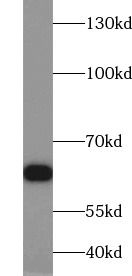Products
RELA antibody
| Synonyms: | Transcription factor p65|Nuclear factor NF-kappa-B p65 subunit|Nuclear factor of kappa light polypeptide gene enhancer in B-cells 3|RELA|NFKB3 antibody | ||
| Catalogue No.: | FNab06089 | Reactivity: | Human, Mouse, Rat, Pig |
| Host: | Rabbit | Tested Application: | ELISA, IHC, IF, IP, WB, FC |
| Clonality: | polyclonal | Isotype: | IgG |
| Size | Price |
|---|---|
| 100µg | Inquiry |
- SPECIFICATIONS
- CITATIONS
- FIGURES
- CONDITIONS
- FAQS
- Product Name
- RELA antibody
- Catalogue No.
- FNab06089
- Size
- 100μg
- Form
- liquid
- Purification
- Immunogen affinity purified
- Purity
- ≥95% as determined by SDS-PAGE
- Clonality
- polyclonal
- Isotype
- IgG
- Storage
- PBS with 0.02% sodium azide and 50% glycerol pH 7.3, -20℃ for 12 months(Avoid repeated freeze / thaw cycles.)
- Immunogen
- v-rel reticuloendotheliosis viral oncogene homolog A(avian)
- Alternative Names
- Transcription factor p65|Nuclear factor NF-kappa-B p65 subunit|Nuclear factor of kappa light polypeptide gene enhancer in B-cells 3|RELA|NFKB3 antibody
- UniProt ID
- Q04206
- Observed MW
- 65 kDa
- Tested Applications
- ELISA, IHC, IF, IP, WB, FC
- Recommended dilution
- WB: 1:500-1:5000; IP: 1:500-1:5000; IHC: 1:50-1:200; IF: 1:10-1:100
 HeLa cells were subjected to SDS PAGE followed by western blot with FNab06089(p65 antibody) at dilution of 1:1000
HeLa cells were subjected to SDS PAGE followed by western blot with FNab06089(p65 antibody) at dilution of 1:1000
 IP Result of anti-p65 (IP:FNab06089, 3ug; Detection:FNab06089 1:1000) with HeLa cells lysate 5000ug.
IP Result of anti-p65 (IP:FNab06089, 3ug; Detection:FNab06089 1:1000) with HeLa cells lysate 5000ug.
 Immunohistochemistry of paraffin-embedded human liver cancer using FNab06089(p65 antibody) at dilution of 1:50
Immunohistochemistry of paraffin-embedded human liver cancer using FNab06089(p65 antibody) at dilution of 1:50
 Immunofluorescent analysis of HepG2 cells, using FNab06089(RELA antibody)at 1:25 dilution and Rhodamine-labeled goat anti-rabbit IgG (red).
Immunofluorescent analysis of HepG2 cells, using FNab06089(RELA antibody)at 1:25 dilution and Rhodamine-labeled goat anti-rabbit IgG (red).
- Background
- Nuclear factor k B(NF-kB) is a sequence-specific DNA-binding protein complex which regulates the expression of viral genomes, including the human immunodeficiency virus, and a variety of cellular genes, particularly those involved in immune and inflammatory responses. The members of the NF-Kb family in mammalian cells include the proto-oncogene c-Rel,p50/p105(NFkB1), p65(RelA), p52/p100(NFkB2), and RelB. All of these proteins share a conserved 300-amino acid region known as the Rel homology domain which is responsible for DNA binding, dimerization, and nuclear translocation of NF-Kb. The p65 subunit is a major component of NF-Kb complexes and is responsible for trans-activation. NF-kappa-B heterodimeric p65-p50 and p65-c-Rel complexes are transcriptional activators. The NF-kappa-B p65-p65 complex appears to be involved in invasin-mediated activation of IL-8 expression. The inhibitory effect of I-kappa-B upon NF-kappa-B the cytoplasm is exerted primarily through the interaction with p65. p65 shows a weak DNA-binding site which could contribute directly to DNA binding in the NF-kappa-B complex. It associates with chromatin at the NF-kappa-B promoter region via association with DDX1. This antibody is a rabbit polyclonal antibody raised against residues near the N terminus of human RELA.
- Journal:
- Molecular Therapy Nucleic Acids
- Author:
- Department of Hematology, The First Hospital of Jilin University, Changchun, Jilin, 130031, China
- Sample:
- DLBCL cells
- Cited Date:
- 2024-10-08
- Product:
- Journal:
- Turkish Journal of Gastroenterology
- Cited Date:
- 2020-05-12
- Product:
How many times can antibodies be recycled?
First, usually it's not suggested to recycle antibodies. After use, buffer system of antibodies has changed. The storage condition of recycled antibodies for different customers also varies. Thus, the performance efficiency of recycled antibodies can’t be guaranteed. Besides, FineTest ever conducted the antibody recycling assay. Assay results show recycling times of different antibodies also varies. Usually, higher antibody titer allows more repeated use. Customers can determine based on experimental requirements.
Notes: After incubation, we recycle rest antibodies to centrifuge tube and store at 4℃. High titer antibodies can be stored for a minimum of one week. Reuse about three times.
What are components of FineTest antibody buffer?
Components of FineTest antibody buffer are usually PBS with proclin300 or sodium azide, BSA, 50% glycerol. Common preservative is proclin300 or sodium azide, which is widely applied in the lab and industry.
How about the storage temperature and duration of FineTest antibodies?
Most antibodies are stored at -20℃. Directly-labeled flow cytometry antibodies should be stored at 2 - 8℃. The shelf life is one year. If after sales issues for purchased antibodies appear, return or replacement is available. Usually, antibodies can be still used after the one-year warranty. We can offer technical support services.
Is dilution required for FineTest antibodies? What’s the dilute solution?
Directly-labeled flow cytometry antibodies are ready-to-use without dilution. Other antibodies are usually concentrated. Follow the dilution ratio suggested in the manual. Dilute solution for different experiments also varies. Common antibody dilution buffers are acceptable(e.g. PBST, TBST, antibody blocking buffer).
How to retrieve antibodies for immunohistochemistry?
Common retrieval buffers: Tris-EDTA Buffer(pH 9.0); Citrate Buffer(pH 6.0)
Heat induced antibody retrieval:
Method 1: Water-bath heating: Put the beaker with retrieval buffer and slide in the boiling water bath. Keep the boiling state for 15min. Naturally cool to room temperature;
Method 2: Microwave retrieval: Put the beaker with retrieval buffer and slide in the microwave oven. Heat at high power for 5min, Switch OFF for 3min, Heat at medium power for 5min. Naturally cool to room temperature.
How to choose secondary antibodies?
(1) Secondary antibodies react with primary antibodies. Thus, secondary antibodies should be against host species of primary antibodies. E.g. If the primary antibody is derived from rabbit, the relevant secondary antibody should be against rabbit. E.g. goat anti rabbit or donkey anti rabbit.
(2) Choose secondary antibody conjugates according to the experimental type, e.g. ELISA, WB, IHC etc. Common enzyme conjugated secondary antibodies are labelled by HRP, AP etc. Fluorescin or dye labelled secondary antibodies are applied in immunofluorescence and flow cytometry(e.g. FITC, Cy3).
